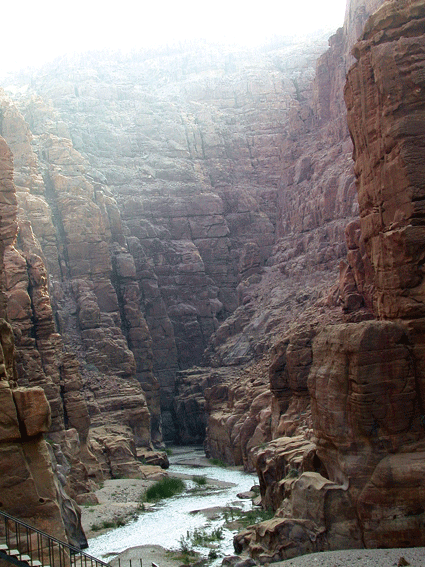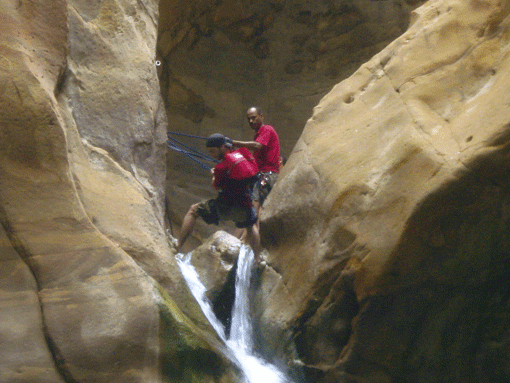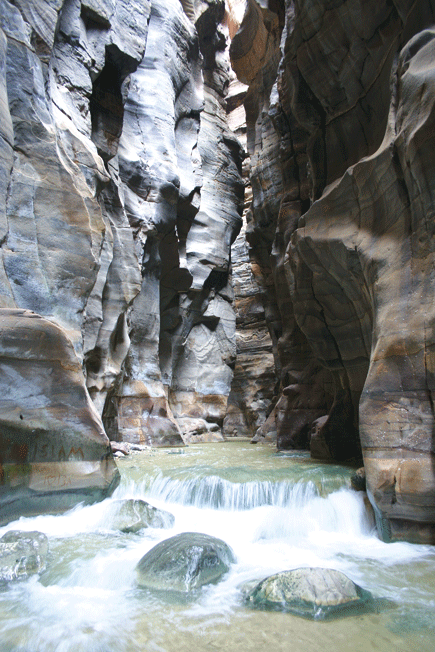
Travel
Wadi Mujib
Roping Down the Waterfalls

If you love nature and outdoor thrills, experience Wadi Mujib; it’s an adventure of a lifetime.
There, you are not only going to see the lowest-elevation nature reserve in the world.
You’re going to climb down!
By: Noor Al Saleh
It is essentially the Jordanian version of the Grand Canyon, located deep within the Wadi Mujib gorge, 130 km South of Amman as it enters the Dead Sea at 410m below sea level. The reserve extends to the Karak and Madaba mountains to the North and South, reaching 900m above sea level in some places.
The Jordan Valley has been a major attraction for tourists from all over the world, with its hills, valleys and waterways providing a natural playground for a multitude of outdoor activities, from leisurely walks to exhilarating horseback rides and challenging climbs. 
Whoever called Wadi Mujib an undiscovered gem was right. Being a Jordanian myself, I have repeatedly visited the Jordan Valley area, specifically the Dead Sea, but it never crossed my mind to undertake an adventure there. It’s probably because most of us have lost the passion for adventure that filled our childhood, that when we choose to break from the monotonous, routine of daily life, we find ourselves picking a place where we can relax and meditate.
Wadi Al Mujib remains one of the most dramatic and unspoiled areas of natural beauty in Jordan. If you have ever been to Petra, you may notice that the place is a version of Siq, with the awe-inspiring colors of rocks and the amazing way the mountain seems to be split.
We took the longest trail. The six-hour-trail began at the visitor center by the Mujib Bridge on the Dead Sea Highway from where a guide escorted us. We took pickups to reach the area and start our adventure. That was an experience in itself, bouncing right and left in the back of the pick-up truck and holding onto anything that would keep us from falling.
Then for an hour and a half, we were dipping up and down across a number of dry wadis, until we reached the river and the guide started taking us through a series of cascading waterfalls, each more challenging than the other. The nature of the rocks is such that you can put your hands and feet there, yet their steep features give you a sense of exhilaration that keeps you alert all the time. We did not know the ‘safe’ rocks from those that are not, and a rock fall was always to be watched out for and expected. Although the members of the group barely knew each other, each one, took it upon himself to be responsible for the person in front, trying to help out as much as possible and giving a hand when needed. Most of the time, the water would not get deeper than our knees, but there were areas where the water went up to mid-chest.
While trouncing through the water, one can see the rich biodiversity of the reserve. We learned from the guide that during ecological surveys there, four plant species never before recorded in Jordan were discovered, along with the rare Syrian wolf, Egyptian mongoose, the Blanford fox, caracal, striped hyena, two species of viper, the venomous desert cobra, and large numbers of raptors.
The reserve is also home for over 420 species of plants, 102 species of permanent and migratory birds and 10 species of carnivores including the Red Fox, Jackal, Wild Cat, Caracal, Badger, Mongoose, Wolf and Arabian Leopard that have been recorded to date. Some of the valley’s mountainous areas offer a safe haven to various species of cats, goats and other mountain animals. The areas are, of course, difficult to reach.
Mujib’s sandstone cliffs are also an ideal habitat for one of the most beautiful mountain goats in the world, the Nubian Ibex. Due to over hunting, the natural Ibex herds have declined over the years, prompting Jordan’s Royal Society for the Conservation of Nature to found a captive-breeding programme for the Ibex within the Mujib Nature Reserve.
While the guide was busy explaining to us the interesting facts, our minds were somewhere else. We were heading to the real adventure—abseiling the 20-meter waterfall. We reached the point from where we were about to rope-down a really tall waterfall. We were asked by the guide to stand in a circle and listen to his instructions. His serious tone made many of us not really sure about wanting to go through with this. But what options did we have? We couldn’t go back, it’s the only way out. We were stuck. What broke the tense atmosphere was witnessing one of the group members confessing he is really afraid of heights, but he, too, had no other option.
So we all banded together, encouraging and pushing each other through the most difficult part of the adventure. And we did it. The deafening sound of the water while going down and feeling it pouring aggressively over our heads was indescribable.
We sat down in the middle of the water waiting for each other to get down the waterfall. We sat, talked and sang and took pictures, until it was time to head off.
We were exhausted but the feeling of accomplishment overwhelmed us. Walking together while finding our way back to the cars only shows what we have achieved. We came in separate groups, barely knowing each other, but left as one group.